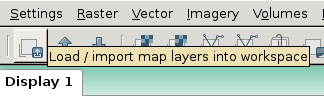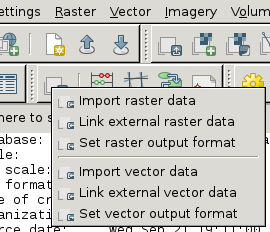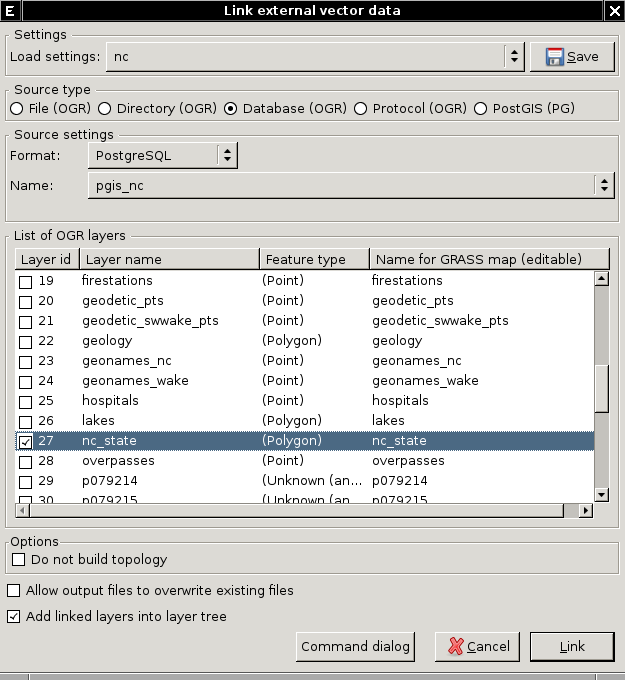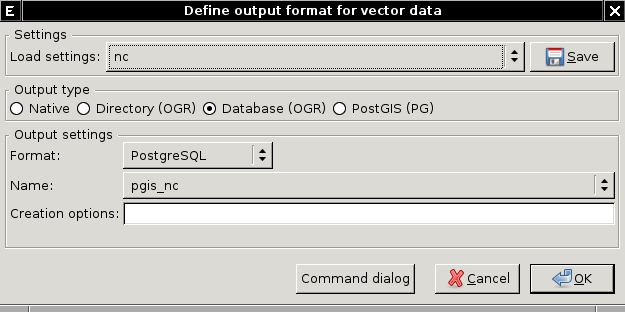Working with external data in GRASS 7: Difference between revisions
mNo edit summary |
m (→Using wxGUI) |
||
| Line 259: | Line 259: | ||
[[Image:wxgui-v.external.png|center|thumb|400px|wxGUI {{cmd|v.external|version=70}} dialog]] | [[Image:wxgui-v.external.png|center|thumb|400px|wxGUI {{cmd|v.external|version=70}} dialog]] | ||
[[Image:wxgui-v.external.out.png|center|thumb|400px|wxGUI {{cmd|v.external.out|version=70}} dialog]] | [[Image:wxgui-v.external.out.png|center|thumb|400px|wxGUI {{cmd|v.external.out|version=70}} dialog]] | ||
== See also == | |||
* [[PostGIS]] | |||
* [[PostGIS Topology]] | |||
[[Category:Vector]] | [[Category:Vector]] | ||
[[Category:FAQ]] | [[Category:FAQ]] | ||
[[Category:GRASS 7]] | [[Category:GRASS 7]] | ||
Revision as of 13:07, 29 November 2012
This page explains how to effectively work with external raster and vector data in GRASS 7. See also PostGIS and PostGIS Topology.
Raster data
External raster data can be linked via r.external. List of supported formats can be determined by
r.external -f
To link file-based data formats, eg. GeoTiff
r.external input=ncrast/urban.tif output=urban
Vector data
See trac OGR interface and PG interface page for development issues.
Link external data
External vector data can be linked via v.external using OGR library or GRASS-PostGIS data driver (format=PostgreSQL). List of supported formats can be determined by
v.external -f
To link file-based data formats, eg. ESRI Shapefile using OGR library
v.external dsn=ncshape/ layer=railroads
Assuming that railroads.shp is located in directory ncshape.
To link database-based data formats, eg. PostGIS using GRASS-PostGIS data driver
v.external dsn=PG:dbname=pgis_nc -l
PostGIS database <pgis_nc> contains 55 feature table(s):
...
bridges
...
v.external dsn=PG:dbname=pgis_nc layer=bridges output=b
Assuming that PostGIS layer named bridges is located in database pgis_nc. This layer is linked to GRASS mapset as vector map with name b. v.external also builds pseudo-topology over simple features which enables GRASS to access linked vector data on level 2. Note that data are stored as simple features, so no full topology support can be build based on this data.
By default PostGIS feature tables are linked using built-in GRASS-PostGIS data driver - it means that PostGIS geometry data are accessed by GRASS directly without any abstract level (like OGR library). When GRASS is built without PostgreSQL support or environmental variable GRASS_VECTOR_OGR exists, then GRASS will access PostGIS data using OGR-PostgreSQL driver.
Direct access to external data
External data can be accessed using OGR library via virtual mapset OGR.
v.info map=PG:dbname=pgis_nc@OGR layer=bridges
Direct access using GRASS-PostGIS data driver is not currently possible.
Create new OGR layers using GRASS modules
v.extract showcase
GRASS 7 also supports write access to the external data using OGR or GRASS-PostGIS data driver. Showcase bellow:
v.external dsn=PG:dbname=pgis_nc layer=bridges output=b
v.out.ascii input=b where="cat < 10" --q
375171.4992779|317756.72097616|1
374247.5192779|317487.13697616|2
380230.2292779|316900.97897616|3
379191.4162779|316419.09697616|4
388958.8222779|316332.04697616|5
375875.2662779|316319.89597616|6
376393.5282779|316155.96797616|7
380647.5282779|316022.61797616|8
376739.6982779|315970.62597616|9
v.external.out dsn=PG:dbname=pgis_nc format=PostgreSQL
v.extract input=b output=b_9 where="cat < 10"
v.external dsn=PG:dbname=pgis_nc -l
PostGIS database <pgis_nc> contains 56 feature table(s):
b_9
bridges
...
Example of direct access to external data without creating a link (only OGR data driver)
v.out.ascii input=PG:dbname=pgis_nc@OGR layer=b_9
375171.4992779|317756.72097616|1
374247.5192779|317487.13697616|2
380230.2292779|316900.97897616|3
379191.4162779|316419.09697616|4
388958.8222779|316332.04697616|5
375875.2662779|316319.89597616|6
376393.5282779|316155.96797616|7
380647.5282779|316022.61797616|8
376739.6982779|315970.62597616|9
Create new empty OGR/PostGIS layer
Check connection settings:
(for GRASS-OGR data driver)
v.external.out -p
dsn: /path/to/shapefiles
format: ESRI Shapefile
(for GRASS-PostGIS data driver)
v.external.out -p
conninfo: dbname=pgis_nc
format: PostGIS
New OGR/PostGIS layer can be created using v.edit, note that you need to specify feature type for newly created OGR/PostGIS layer (point, line or boundary).
v.edit map=pmap tool=create type=point
Check created OGR layer (direct access, OGR data driver only):
v.info -t map=PG:dbname=pgis_nc@OGR layer=pmap
...
points=0
...
Check created OGR/PostGIS layer (link):
v.external dsn=PG:dbname=pgis_nc layer=pmap
v.info -t map=pmap
Adding new point feature:
cat point.txt P 1 1 375171.4992779 317756.72097616 1 1
v.edit -n map=pmap tool=add input=point.txt v.info -t map=pmap ... points=1 ...
v.select speed test
Testing data:
- DBF input (attributes only)
g.mapset user1 db.connect -p driver:dbf database:$GISDBASE/$LOCATION_NAME/$MAPSET/dbf/
g.copy vect=bridges,b --o g.copy vect=urbanarea,u --o
- SQLite input (attributes only)
g.mapset sqlite db.connect -p driver:sqlite database:$GISDBASE/$LOCATION_NAME/$MAPSET/sqlite.db
g.copy vect=bridges,b --o g.copy vect=urbanarea,u --o
- Export data to PostGIS database (from mapset 'sqlite')
v.out.ogr input=b dsn=PG:dbname=pgis_nc format=PostgreSQL olayer=bridges --o v.out.ogr input=u dsn=PG:dbname=pgis_nc format=PostgreSQL olayer=urbanarea --o
- PostGIS input (geometry + attributes) - OGR data driver
g.mapset pg_ogr export GRASS_VECTOR_OGR=1 v.external dsn=PG:dbname=pgis_nc layer=bridges output=b --o v.external dsn=PG:dbname=pgis_nc layer=urbanarea output=u --o
- PostGIS input (geometry + attributes) - GRASS-PostGIS data driver
g.mapset pg v.external dsn=PG:dbname=pgis_nc layer=bridges output=b --o v.external dsn=PG:dbname=pgis_nc layer=urbanarea output=u --o
Writing output directly using OGR library (mapset 'pg_ogr'):
v.external.out -p
dsn: PG:dbname=pgis_nc
format: PostgreSQL
Writing output directly using PostGIS data driver (mapset 'pg'):
v.external.out -p
conninfo: dbname=pgis_nc
format: PostgreSQL
- DBF input
time v.select ain=b@user1 atype=point bin=u@user1 btype=area out=b_u ope=overlap --o
real 0m6.059s
user 0m4.780s
sys 0m0.588s
- SQLite input
time v.select ain=b@sqlite atype=point bin=u@sqlite btype=area out=b_u ope=overlap --o
real 0m2.239s
user 0m1.084s
sys 0m0.524s
- PostGIS input
time v.select ain=b atype=point bin=u btype=area out=b_u ope=overlap --o
real 0m20.609s
user 0m7.920s
sys 0m1.644s
Note: Main reason of worse speed is random access used by v.select which is quite costly for OGR layers.
Time consumption for native output:
real 0m1.631s user 0m0.860s sys 0m0.768s
Digitize OGR layer using wxGUI
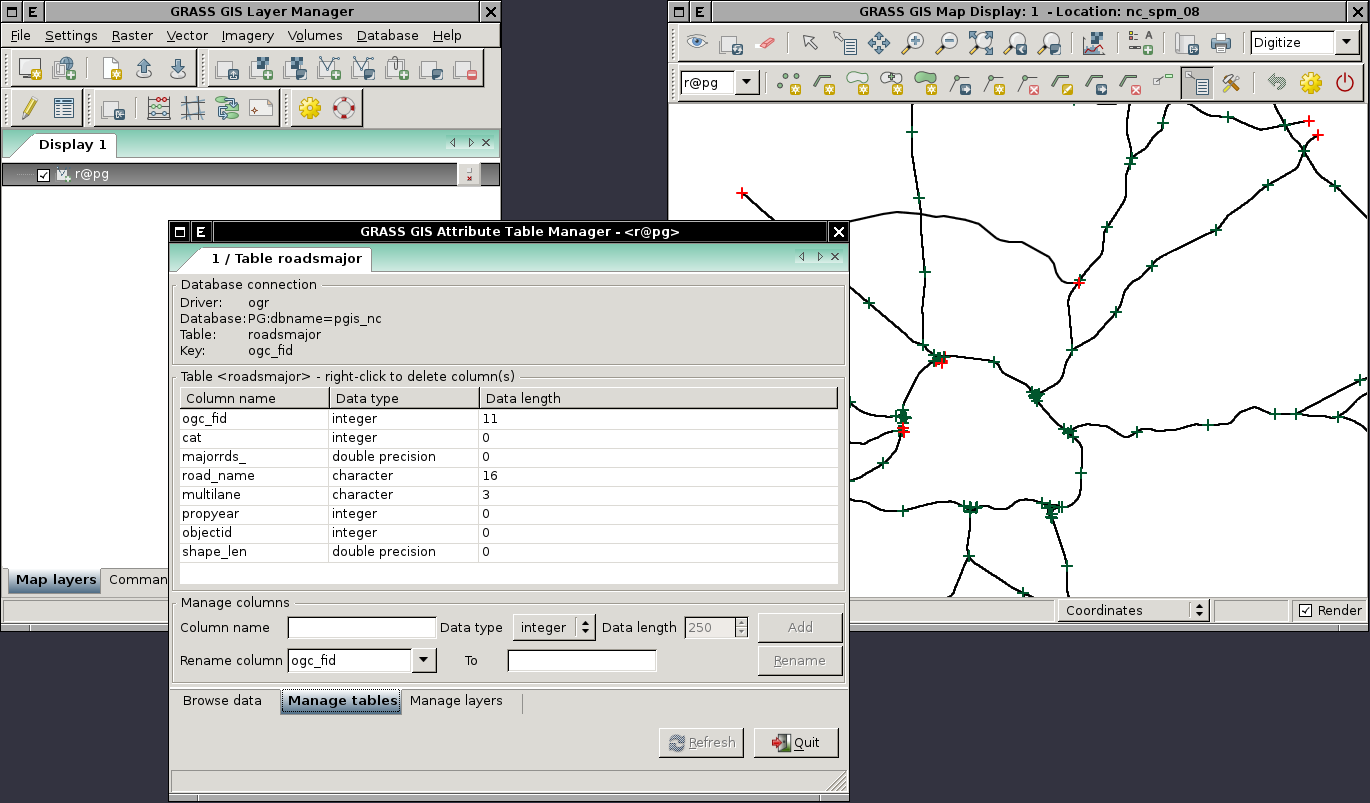
Using wxGUI
From menu
File -> Link external formats

or from toolbar in Layer Manager.
